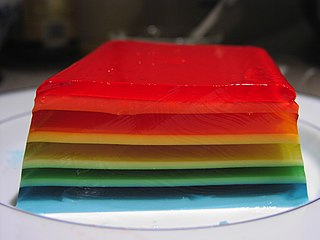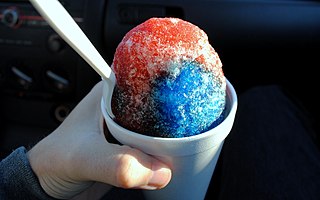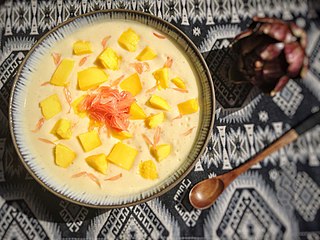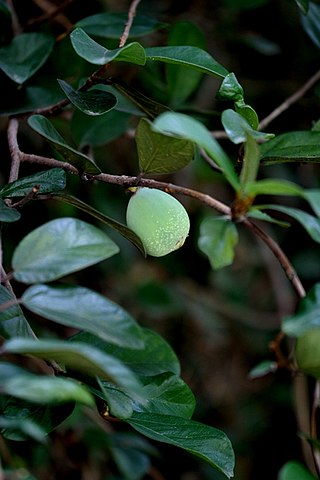
Gelatin desserts are desserts made with a sweetened and flavoured processed collagen product (gelatin), which makes the dessert "set" from a liquid to a soft elastic solid gel. This kind of dessert was first recorded as jelly by Hannah Glasse in her 18th-century book The Art of Cookery, appearing in a layer of trifle. Jelly recipes are included in the 19th-century cookbooks of English food writers Eliza Acton and Mrs Beeton.

Hong dou tang or Hong dou sha is a popular Chinese dish served in Mainland China, Taiwan, Hong Kong, Macau, and places with Chinese diaspora. It is categorized as a tang shui 糖水 or sweet soup. It is often served cold during the summer, and hot in the winter. Leftover red bean soup can also be frozen to make ice pops and is a popular dessert.

Malaysian cuisine consists of cooking traditions and practices found in Malaysia, and reflects the multi-ethnic makeup of its population. The vast majority of Malaysia's population can roughly be divided among three major ethnic groups: Malays, Chinese and Indians. The remainder consists of the indigenous peoples of Sabah and Sarawak in East Malaysia, the Orang Asli of Peninsular Malaysia, the Peranakan and Eurasian creole communities, as well as a significant number of foreign workers and expatriates.

Ais kacang, literally meaning "bean ice", also commonly known as ABC, meaning "mixed ice"), is a Malaysian dessert which is common in Malaysia, Singapore and Brunei.

Bingsu, sometimes written as bingsoo, is a milk-based Korean shaved ice dessert with sweet toppings that may include chopped fruit, condensed milk, fruit syrup, and red beans.

Grass jelly, also known as leaf jelly or herb jelly, is a jelly-like dessert originating from China. It is commonly consumed in East Asia and Southeast Asia. It is created by using Chinese mesona and has a mild, slightly bitter taste. Grass jelly was invented by the Hakka people who historically used the food to alleviate heat stroke after long days working in the field. The dish was introduced to Southeast Asia by the Chinese diaspora. It is served chilled, with other toppings such as fruit, or in bubble tea or other drinks. Outside Asia, it is sold in Asian supermarkets.

Cendol is an iced sweet dessert that contains droplets of pandan-flavoured green rice flour jelly, coconut milk and palm sugar syrup. It is commonly found in Southeast Asia and is popular in Indonesia, Malaysia, Brunei, Cambodia, East Timor, Laos, Vietnam, Thailand, Singapore, Philippines, and Myanmar. Next to the green jelly, additional toppings might be added, including diced jackfruit, sweetened red azuki beans, or durian.

Shaved ice is a large family of ice-based desserts made of fine shavings of ice and sweet condiments or syrups. Usually, the syrup is added after the ice has been frozen and shaved—typically at the point of sale; however, flavoring can also be added before freezing. The dessert is consumed worldwide in various forms and ways. Shaved ice can also be mixed with large quantities of liquid to produce shaved ice drinks.

Ching bo leung is a sweet, cold dessert soup of Chinese origin and commonly served in Cantonese cuisine, Hainanese cuisine and Guangxi cuisine. It is a popular dessert in Malaysia and Singapore. It is a type of tong sui. In Singapore it is known as 清汤. It is known as sâm bổ lượng or chè sâm bổ lượng in Vietnam.

Chè is any traditional Vietnamese sweet beverage, dessert soup or stew, or pudding. Chè includes a wide variety of distinct soups or puddings. Varieties of Chè can be made with mung beans, black-eyed peas, kidney beans, tapioca, jelly, fruit, and coconut cream. Other types are made with ingredients such as salt, aloe vera, seaweed, lotus seed, sesame seed, sugar palm seeds, taro, cassava and pandan leaf extract. Some varieties, such as chè trôi nước, may also include dumplings. Chè are often prepared with one of a number of varieties of beans, tubers, and/or glutinous rice, cooked in water and sweetened with sugar. In southern Vietnam, chè are often garnished with coconut creme.

Aiyu jelly, known in Amoy Hokkien as ogio, and as ice jelly in Singapore, is a jelly made from the gel from the seeds of the awkeotsang creeping fig found in Taiwan and East Asian countries of the same climates and latitudes. The jelly is not commonly made or found outside of Taiwan, Malaysia, and Singapore, though it can be bought fresh in specialty stores in Japan and canned in Chinatowns. It is also used in Taiwanese cuisine.

Ficus pumila var. awkeotsang, also known as the jelly fig, aiyu, or ai-yu, is a variety of Ficus pumila, and a member of the fig family Moraceae, native to Taiwan. The plant is known for its use in making aiyu jelly.

Chhoah-peng or Tsua bing, also known as Baobing in Mandarin, is a shaved ice dessert introduced to Taiwan under Japanese rule, and then spread from Taiwan to Greater China and countries with large regional Overseas Chinese populations such as Malaysia and Singapore. It is especially popular in Taiwan where the dish has a variation called xuehua bing (雪花冰), in which the ice is not made out of water but milk.

Chinese desserts are sweet foods and dishes that are served with tea, along with meals or at the end of meals in Chinese cuisine. The desserts encompass a wide variety of ingredients commonly used in East Asian cuisines such as powdered or whole glutinous rice, sweet bean pastes, and agar. Due to the many Chinese cultures and the long history of China, there are a great variety of desserts of many forms.

Namkhaeng sai is a Thai version of shaved ice or snow cone. It is also known as wan yen or chamba. Namkhaeng sai is simply shaved ice in a bowl, poured on top with sweet syrup and condensed milk

Almond tofu is a soft, jellied dessert made of apricot kernel milk, agar, and sugar popular throughout East Asia.

Phuket cuisine originates from Phuket, Thailand and has Chinese, Malaysian, and Thai influences.

















